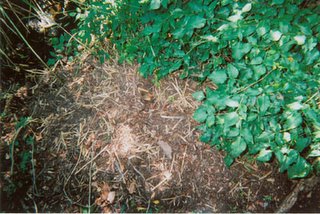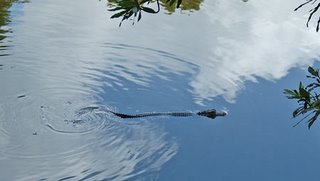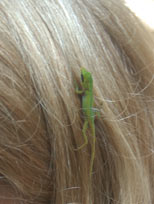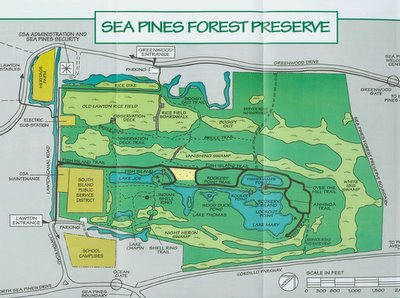Happy Thanksgiving!
Thursday, November 24, 2005
Wednesday, November 23, 2005
More on American Alligators in Sea Pines Part II

This is a photo of an *abandoned* alligator nest, which you can see yourself near the right side of Rice Field Boardwalk as you go in, which is located in the Sea Pines Forest Preserve. (see the map above). If you go here you are NOT allowed to take bits of the eggshells. That is a big no-no as you probably, um, know. :S
Alligator mothers are extremely protective of their eggs and will not hesitate to attack those who try to snag em' for their own devilish reasons. Alligator mothers don't sit on eggs all the time, but cover them with leaf litter and other stuff. Have you ever gone close to a compost pile? If you have, it was probably warm over there. Bacteria break down leaves and other stuff, and the bacteria reproduce rapidly, resulting in heat. Well, this process helps keep momma's little babies warm, while she looks for food.
More on American Alligators in Sea Pines

This a photo of a young 'gator in my back lagoon. If you look closely, you can see the osteoderms , or, the bony plates on its back which help it look like a log, so it can catch unsuspecting fish and waterfowl, etc. In my opinion this little guy doesn't seem much like a big bulky log. But it doesn't have to, because young alligators like this one only eat snails, insects, and other invertebrates, and the occasional frog or small fish. What a diet. :('
Alligators don't hibernate, like some animals, but they do go into an inactive state. They hide in underwater or underground dens. But if it gets sunny, and if it isn't cold, they will "wake up" and come out. I wonder where this one's den is !?
Today's wildlife focus: The American Alligator
Alligators living around here can be found just about anywhere that has freshwater and that can accomodate an alligator of its size. They are numerously found on the banks of Hilton Head Prep, and swimming in or sunbathing near the Sea Pines Forest Preserve. We even have a few in our back lagoon! (photo coming later today) They sunbathe to retain a steady temerature of 89* in body temperature. They eat birds, crabs, fish, snakes, basically anything they can get their greedy claws on! Sadly, this diet can easily be adapted to Big Macs, burritos, french fries, Cheetos, and other stuff that "comes their way". If you feed them, then they will constantly expect more, even though they only need 1 lb. of food a week. If not fed, (or even if they are, if they're in a bad mood) they will get mad, and however slow they may look, you DON'T want to get a gator mad. *slashing motion across the neck* Even if they dont eat you, they will prob'ly try to get other people, and will have to be killed. So if you leave 'em like they are, both of you will be the better for it! :D More coming today!
Tuesday, November 22, 2005
Carolina Anoles

This is a photo of a Carolina Anole (AKA Green Anole) in my hair. This one looks almost exactly like the one I saw today on my bike ride ! Anoles live everywhere around Sea Pines, From The Sea Pines Forest Preserve to my backyard! They have red wattles, and will puff 'em out if they're frightened or if they are trying to attract a mate. They can also change colors from green to brown, like a chameleon. I wonder why they called it a Green Anole, if it can change colors?! These eat all sorts of insects and spiders, including cockroaches! Yuck! :(' This one is pretty young, by the looks of him, and very delicate at that. If you break off an anole's tail at a certain point, it will grow back. But I do not suggest doing this to see what happens, because it probably hurts the lizard. I'm not sure, as I have not read anything about whether it hurts or not, and I have never experienced being a lizard when i's tail gets pulled off. :/
Today I saw....
Today I was biking, and I saw a squashed shrew. It doesn't say what kind it was in my books, but it was pretty unrecognizable anyway. :( I also saw a juvenile Carolina Anole, or a tiny lizard for short. It was sunbathing on the bikepath. If you know about shrews, or tiny rodents around Hilton Head, please comment.
Great Book Link!
The best reference for Sea Pines wildlife, or wildlife on Hilton Head for that matter, that I have found is "Tideland Treasure" by Todd Ballantine. You can get a link to it at the sidebar below. It has very specific information, hand-drawn and hand-lettered entries, and it is very useful!
Monday, November 21, 2005
Sea Pines Wildlife
This blog is for observing, reporting, and identifying animals in the gated community of Sea Pines, Hilton Head Island, South Carolina. This blog will give identification of animals sighted, animal book recommendations, tips for observing specific animals and so on. Please report animals you've seen in Sea Pines, describe them, and I'll identify them as best I can.
Subscribe to:
Comments (Atom)

